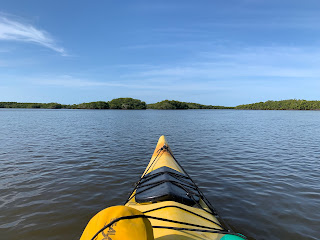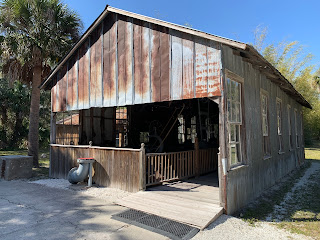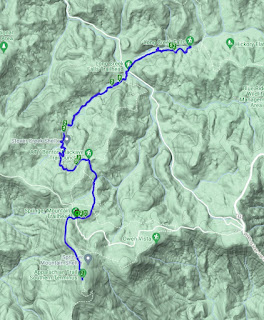Earlier this year, I was considering how and where to spend some of my vacation time. I realized that I have never visited southern Florida or Everglades National Park. When I found an outfitter that guides multi-day kayak and camping trips deep into these mysterious waters, I thought that would really be the way to take it all in. Having run half-marathon this morning and already visiting a couple of other sites on my way to my hotel in Everglades City, I was more than ready to crash at my hotel room for a good nights sleep. I expected I would need it. I've done multi-day paddles before, but those were limited to two or three days and normally twenty-five miles or less. Knowing our plan was for about forty-eight miles over five days, I knew I was in for a strenuous adventure.
Day 1
I arrived at the Everglades National Park make-shift visitor center at the end of Oyster Bar road. It seems a hurricane in recent years had destroyed the structure here and while a new permanent visitors center is under construction, currently, a decked out double-wide is serving this purpose.
Looking around the parking area, I try to locate my guide and/or group. I ask a couple of gentlemen and as luck would have it, one of them is my guide. He asks me to sign the normal waiver and then follows me back to my car with a couple of drybags for me to stow all of my gear of the trip. He had warned us to pack very light, but as a backpacker, I would have done that anyway. I'm easily able to fit all of my clothes and other necessities into the two (10L and 5L) dry bags. A few moments later, another couple arrives and as it turns out this will be our entire group. Apparently, there was one last minute cancellation, leaving a party of four in total. Ah well, small groups are sometimes better.
Dave, our guide, helps us pack the kayaks and make the necessary adjustments, which area already on the boat launch ramp. Today, Dave and I will be paddling single twenty-one foot ocean-going fiberglass kayaks, while the other couple paddle a larger tandem. All of camping gear has already been packed neatly away into the storage bins of the three boats. With that, we are off on our adventure.
We start by paddling out into Chokoloskee Bay and then ducking under a small bridge, which S Copeland Ave passes over, and then down a long shoot that runs parallel to the road. Eventually it dumps us out back into the bay and we paddle alongside Chokoloskee Island, which is a small community built upon the largest midden (or oyster shell mound) in the park. These middens started as dumping grounds for the local Native Americans and over the centuries were built up into substantial land masses rising above these shallow waters.
We'll be spending tonight on the Crooked Creek Chickee, which after paddling into a little cove, becomes clearly visible. A chickee is nothing more than a platform built above the shallow waters for visitors to pitch their tents on. This one is made up of two 12' X 12' platforms connected by a twenty foot walkway with an outhouse attached to it. Now at low tide, the platform is about four feet above the water level and getting out of the kayaks and unloading them is quite the ordeal. Our guide has done this countless times though and coaches and assists all of us until we and all of the required gear are safely out of the boats and on the platform.
As we erect our tents and our guide sets up the kitchen for the evening, we discuss our adventures for the day and wonder at how the water level will be when we wake in the morning. Before dinner, we are treated to cans of Sweetwater IPA and some cheese and crackers. We dangle our legs over the water and enjoy these treats while Dave makes our evening meal. Tonight, we'll be having fried grouper, beans, a salad, and garlic bread. It's all quite delicious.
Day 2
I awake early and begin stirring. Soon, I crawl out of my tent and make my morning visit to the toilet. Though the sun isn't up yet, the others wake up soon after and Dave begins making breakfast. We eat a bite, enjoy some coffee, and begin breaking down our tents and packing. Loading our gear back into the boats is as challenging as taking it out was, but we manage it in a very systematic way under our guide's supervision. And then, loading ourselves into the boat is another interesting challenge, but with Dave's help, everyone manages to climb in without incident.
We paddle just a bit further on the Lopez River and then into the Wilderness Waterway across Sunday Bay against a strong headwind. The paddling is pretty exhausting, but I do my best to keep up. Along the way we see a number of dolphins swimming around us. Beautiful creatures and I wish we could get better views, but no doubt, they are in search of their morning meal in these shallow waters.
From Sunday Bay, we pass into Oyster Bay continually surrounded by mangrove forests, which go on as far as the eye can see. The water remains very shallow here. High tide was just about the time we were having breakfast, but even now the waters are no more than three feet deep in most places.
Dave guides us to a oyster bar with a few mangroves growing out of it, but with plenty of room for us to land our boats and hop out to relieve ourselves and to enjoy a quick lunch, which he had prepared while we ate breakfast. As I climb out of my boat, I'm very cautious of the incredibly sharp oyster shells that make up clusters every where we step. I feel a little bad stepping on them, but there really aren't any alternatives. Having finished our sandwiches and gotten a short rest, we're back on the water.
Watson Place is a midden, like Chokoloskee Island, though much smaller. For all intents and purposes, it is dry ground and will be our campsite for the next two nights. After paddling right at 10 miles today, I'm ready for a break. There is a small dock attached to the mainland and I take advantage of this to sit in my folding chair and relax a little bit before putting up my tent. The others follow suit, while Dave tells us of the man this place is named for. Apparently, Watson had run a small sugar-cane plantation on this midden, but was often unwilling to pay those in his employee. He chose instead to murder some of them, or so the stories go. Eventually, justice caught up to him and he was arrested while purchasing supplies in town. When the Everglades was declared a national park, Watson Place was set up as one of the defined primitive campgrounds.
Dinner was delicious and afterwards, we all spend a little more time out on the dock watching the sun go down. As soon as it does though, the hungry armies of insects invade and I make a run for the protection of my tent. I end a couple of mosquitos that got inside and then fall off into slumber.
Day 3
It was nice sleeping on dry ground last night without fear of rolling off into the water, but as soon as I leave my tent, the bloodsuckers are on me. I dose myself with a healthy shower of bug spray and they seem to leave me alone at least for a bit. This morning, we can be a bit more relaxed since we won't be breaking camp today. Dave makes pancakes and bacon on the stove and we all enjoy our fill over coffee.
He asks if I would want to be in the tandem kayak today, to which I gratefully agree. I'm still tired from battling those winds yesterday and being in the front seat of a tandem with a more experienced paddler in the back is just what my arms need to recover. We load the gear we'll need for the day into the boats and launch back into the Chatham River heading northeast this time. Paddling here in the Everglades seems to be a battle of tides and winds. Luckily, both are with us this morning and the paddling is pretty easy.
We make our way through more mangrove forest and eventually past the Sweetwater Bay Chickee. From there, we paddle into some very narrow passages and see our first alligators. These are big boys of anywhere between eight to eleven feet. We're forced to paddle within just a few feet of a couple of them that are sunning themselves on the mangrove roots. This is more of what I was expecting from the Everglades. That's not to say that what we've seen the last couple of day isn't gorgeous. It's just not the image I had in my head. In my imagination, I expected it to be much more of these narrow passage ways and alligators at every turn.
Soon, it's time to load ourselves back into our boats. By this time, our 'friend' has disappeared. As we paddle back towards Watson Place, we continue to see amazing wildlife. Four alligators in total, hundreds of birds and at one point, an osprey launches into the air just ahead of me.
We paddled about 8.6 miles today, out and back and even with the appetizer, we're all hungry and ready for dinner. Tonight, we feast on fried chicken, stuffing, corn on the cob and individual key lime pie slices for desert. Scrumptious!
After dinner, we all turn in early to escape the bloodsuckers, but I struggle to fall asleep tonight. I always toss and turn when camping, but I can't seem to doze off for some reason today. Perhaps the alligator encounter is on my mind or perhaps, I'm missing my family. I'm not sure, but before I figure it out, I finally have fallen off to never-never land.
Day 4
Our fourth day begins much as our third, but with the added pressure of breaking camp this morning. After breakfast, we do just that and are soon paddling the Chatham once again. In the distance, I see something that I think is another alligator, but it doesn't seem to move and if it were an alligator, it would be a HUGE one. We paddle a bit closer and discover a black rain jacket floating on top of the water. The river channel here is a bit deeper and motorized craft can pass through (though carefully). I use my paddle to life the jacket out of the water and we tuck it under one of the bungies. Always good to pick up trash when you can.
Luckily, we're paddling with the current again this morning and I'm not wearing out my arms and core. Soon we reach the mouth of the Chatham River and enter the open waters of the Gulf of Mexico. That said, the continental shelf is some fifty miles long and we're still paddling over very shallow waters. The color has changed though. Where water in the interior was a murky brown, the waters of the gulf have a deeper green tint to them. We see a dozen or more dolphins as we to our destination for the day.
We stop at on one of the keys for lunch. This is another oyster bed, but this one has also been built up by sand and bleached-white dead trees that were blown up during the last hurricane. This one is much larger that most places we've stopped for our lunches, and we all take a short time to explore before loading back into the boats and continuing our paddle to Pavilion Key.
Pavilion Key is a small island that forms a shape like a narrow letter 'C' with sandy beaches on most of its shoreline. We paddle around to the back (gulf) side of the island and land our boats into the white sands. This will be our campsite for the night. Among the giant conch shells we pull out boats well out of the water and decide where to pitch our tents. I decide on a spot north of the boats just above the high tide line, while the couple goes south of the boats. Dave walks a short distance into the islands interior and erects his tent and our kitchen there. The island is only a couple of hundred feet wide here and so, it's not like we have to walk very far.
The others decided to walk a ways down the beach while I cleaned up, but follow my lead upon their return. Dave cracks open a bottle of pinot noir. I had predicted that we would be getting red wine tonight, as it is really the only alcoholic beverage one can tolerably drink at room temperature and after three four days of the Florida heat, nothing was cold any longer.
For our dinner tonight, we are served a large helping of cheese tortellini with a pesto sauce, Italian sausage, something akin to a waldorf salad and a garlic knot. The meals throughout this trip have been top notch. After dinner, we all retire to the beach near our campsites and build a campfire. They weren't permitted at Watson Place, but here, there is no danger of anything burning other than the dried driftwood we gather for fuel.
I doze off pretty quickly on the combination of sleeping pad and soft sand, but before too long, I'm awakened by the loud squawk of some kind of bird just behind my tent. It startles me as it arouses me from slumber, but I quickly fall back asleep with the cool breeze passing through my tent and the sound of the waves rolling in just a few feet from me.
Day 5
Our last day and return to civilization. We get an early start after enjoying a quick breakfast. While Dave didn't plan for us to be on the water until nearly 9:00 AM, we're packed and paddling before 8:00 AM. I don't think any of us are anxious for this adventure to end, but knowing that a hot shower is in our future is some added motivation.
As we paddle through the Thousand Island section, we encounter many more dolphins and waterfowl. Apparently the alligators don't really come out into this much saltier water very often.
After lunch, we continue north until Chokoloskee Island comes back into view. This time we'll be paddling on the western side of the island and in the distance we see the bridge we paddled under on Monday morning. Beyond, is the boat ramp at the park's visitors center.
And just like that, our adventure is over. We help Dave unload the kayaks and then load them onto his trailer, and then say our goodbyes. It's been an amazing five days exploring this wild environment and I'm thrilled to have been able to enjoy this time with good people. In total, we paddled 47.4 miles, including 11.1 this final day.
I take advantage of the wash room to clean up a bit and put on some fresh clothes from my car. While my new friends are staying in nearby Everglades City, I have to drive about four hours to my hotel for the night in Ocola, FL. Like all great adventures this one has now come to an end, though I will likely stop at a couple of interesting sites on my drive home.

























































